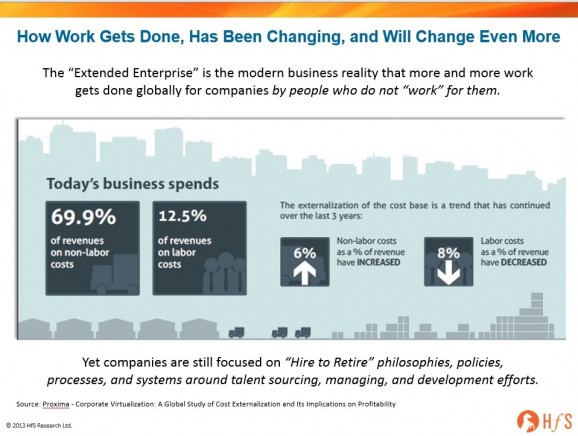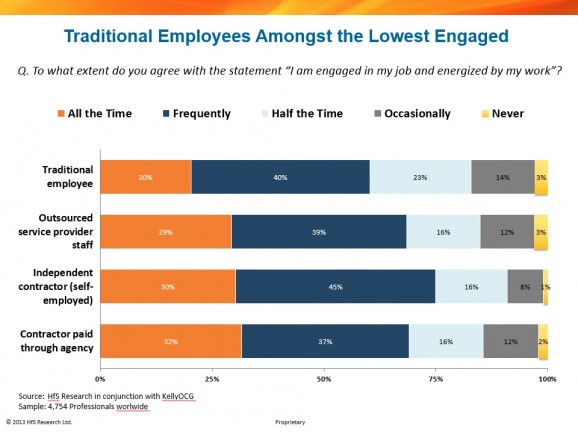The smartest leaders are those who figure out how to get the most out of their staff – to hire the best people they can afford, make sure they are continually energized, and to ship out the poor performers and bad apples on a continual basis.
So why, oh why, do so many Human Resources executives obsess with administering irrelevant processes and buying technology products to fuel these obsessions, when they should be helping their firms’ managers get the best out of their staff? It brings me back to the heyday of HR outsourcing, where so many deals fell by the wayside as they were centered on HR offloading the administrivia to outsourcers and focusing their retained org on the “value add” HR work. Sadly, most organizations quickly discovered most HR people only wanted to deal with administrivia, and HRO was a direct threat to their employment. So end-to-end HRO died a painful death, leaving the outsourcers to focus on discreet administrative processes, namely payroll, benefits and staffing admin, which HR people could administer – and obsess over – to their hearts’ content.
As was so famously pointed out in 2005’s Fast Company’s Why We Hate HR article, the whole HR function needs to be blown and and completely reconstructed with a new set of skills, a renewed purpose and mission to put the HR function back somewhere remotely near the C-Suite table. So, without further ado, it’s time to unleash our own doyenne of the disruptive workforce as she wages her war on weird workforce ways, Christa Degnan Manning…
Time to Put the People Back into the People Business
As noted in my HfS bio, I recently returned to the business research and analysis arena focused on workforce optimization because my last five years’ experience as a line manager and employee in a Fortune 100 firm (supposedly one of the best companies to work for) exposed me to the fact that predominant human resources philosophies, policies, programs, and particularly systems in place today are woefully inadequate and even obsolete for today’s global, virtual, mobile, social, time-starved, knowledge-worker world.
Today’s firms investing more in talent outside of their core organizations
Compounding this challenging reality is the fact that companies continue to downsize their traditional full-time staffs as well as under-invest in the people that remain. Too often, they neglect the knowledge transfer, culture indoctrination, and relationship building with all their “extended-enterprise” workers including contractors, consultants, and third-party service provider partners that are critical to sustained business success.
Validating this workforce shift, procurement outsourcing firm Proxima recently shared public company data analysis quantifying the change in the workforce in the last three years, noting that labor-related costs as a percentage of company revenues have decreased 8% while non-labor costs with third party providers have risen 6%. Yet procurement and HR practices haven’t really changed a whit.
Having just returned from the latest and greatest HR Technology Conference after a five year absence, I can definitively say the majority of organizations and workforce software and service providers are still obsessed with “hire to retire” HR-process driven approaches to supporting the workforce. Yet, I cannot find one person who has gone through that process at a single firm – let alone have that process automated by a sole software provider.
But I do talk to many people – even HR practitioners – overwhelmed by all of the disparate employee and manager Web-based self-service expectations today. Workers are also completely exasperated with the actual HR processes (painful annual calibrations and bogus development plans with no resources or commitment to execute them) and frustrated where processes should exist but don’t (on-boarding and off-boarding have to be the worst offences.)
A third of the modern workforce is disengaged and de-energized
Frustrated by the lack of any progress addressing these workforce realities and our own experiences in the business world, HfS decided to ask what workers worldwide think about their workplaces and how they want to spend their time to be more engaged and productive. While lack of engagement has been well documented (typically by firms, such as Aon Hewitt, Deloitte, Gallup, and Mercer, that sell consulting services for employee engagement strategies), we wanted to investigate, in very practical terms, what could be done to address the root causes of disengagement in the context of the modern business operating models we observe.
By conducting this survey, we hoped to focus attention on the pervasive yet interconnected issues undermining individual as well as business success, and ultimately help our economies return to healthy expansion. So in August and September we collected input from nearly 5,000 workers worldwide across all types of worker: age, geography, role, function, company size, industry and more (special thanks to KellyOCG for its support).
Not only did we document that one in three workers worldwide is disengaged in their jobs half the time or more, but we captured insights into the policies, solutions, preferences, and ultimate challenges to be overcome to achieve higher levels of workforce empowerment and productivity. From time management to software solutions, workers shared eye-opening advice in many areas that sound simple to say but may not be so simple to execute. Let’s examine further…
Why is the full-time employee the least engaged across the extended enterprise?
While the vast majority (75%) of respondents classified themselves as traditional full time workers, they turn out to be the least engaged of the lot. Given the recent waves of downsizings, uncertainty in the economy, and career development limited, the traditional worker gets the message: the company is not willing to invest in you. So why invest in this business?
They are also overtaxed with departed colleagues’ responsibilities in parallel with more self-help duties than ever before. More than 80% of traditional employees reported spending 25% of their time or more on administrative tasks. How many readers can identify with this: an IT help desk request more often results in a more timely service quality survey request than in the computer problem actually being solved?
Speaking of IT, workers spend so much time today setting up and attending virtual meetings and conference calls, they simply have to multitask – literally disengage during meetings – to get any real work done. At the same time, they are being asked to master the disparate self-service apps that have proliferated in the last decade. Whether it’s creating their own help desk or procurement requisition, approving supply contracts and invoices, booking travel or filing expenses, workers are spending more time on these tasks and not in real business-facing activities.
And it is particularly loathsome to the workforce when some other department or function takes a big scorecard win and performance payout bonus for FTE cut cost-savings when part of that savings literally comes out of their work day (if not after-hours – a third of respondents to the study reported consistently working more than 40 hours a week.) Where’s the employment brand commitment to work-life balance there?
Simply-put, many HR executives and HR technology providers have become increasingly irrelevant to corporate strategy with their own focus on automation and administrivia associated with non-value added processes and products, as opposed to solutions designed to improving employee engagement and productivity. They are just adding more things for workers to do that do not help the customer or help the manager (and through them the full population of employees and clients.)
Stay tuned for Part 2, where we discuss, who and what is to blame, the disengagement of managers as well as their subordinates… and the common sense solutions in front of us… click here to read.
Christa Degnan Manning (pictured above) is Research Vice President for HfS Research’s Workforce and Talent practice. You can view here bio here.
Posted in : Business Process Outsourcing (BPO), Captives and Shared Services Strategies, Cloud Computing, Global Business Services, HfSResearch.com Homepage, HR Outsourcing, HR Strategy, SaaS, PaaS, IaaS and BPaaS, Social Networking, Sourcing Best Practises, Talent in Sourcing, the-industry-speaks










Great post–couldn’t agree more. Similar POV was also covered in my post “Fear, Loathing (and HR Technology) in Las Vegas: What Was Missing?” (http://blog.theresearchplatform.com/?p=480) where the anonymous analyst source of “HR technology sounds like an oxymoron” was actually Christa. 🙂
Because HR professionals want to position their function as ‘measurable’ and ‘tangible’ and not ‘touchy, feely’. They look at technology to help them do that across all processes.
Christa,
As I see it in the 90s HR was ‘downgraded’ to a cost-centre function, seen as admin and not an integrated value-add revenue-centre. By deconstructing HR into cost-benefit components the end-to-end value inherent in ‘old-school’ HR was in effect scratched off, rather like you could do with any business function. In essence (in the UK) this approach mirrored the ‘buy staff cheap’ and never mind the quality of accountant, and not customer service, driven businesses. It is also supported by the move away from genuine people development to ‘e-learning’
Paul Anderson
Spot on Andrew and Sarang – it also permits (in the UK) the cheap use of (often) unskilled ‘service staff’ as HR business partners, with a database of unuseable or unfathomable back-office rules and policies!
[…] to ship out the poor performers and bad apples on a continual basis. So why … Read more on Horses for Sources This entry was posted in Ask.com and tagged Distribution, GoogleNewsSubmit, Look, Press, Release, […]
[…] Horses for Sources Can HR ever overcome its obsession with the automation of obsolete processes … […]
Thanks for the comments. Paul – we are pushing to change the mindset and put the “services” back into services staff with improving the employee experience as the key driver and seeing some rays of hope. Stay tuned!
[…] now time for the second installment of Christa Degnan’s Manning’s discussion on HR’s obsession with obsolete processes, and we’ve got some more fascinating data to share from our new employment engagement study […]
[…] Why do so many HR executives obsess with administering irrelevant processes when they should be helping their firms' managers get the best out of their staff? […]
Is think end to end can work if organisations are realistic about what they can achieve, technology can deliver but only if the organisations data people and processes are workable
[…] tried looking at terrible software products that are overpriced, hard to integrate and built on rules-based engines that add little-to-no-value. They’ve made HR the whipping boy for everything dysfunctional and […]